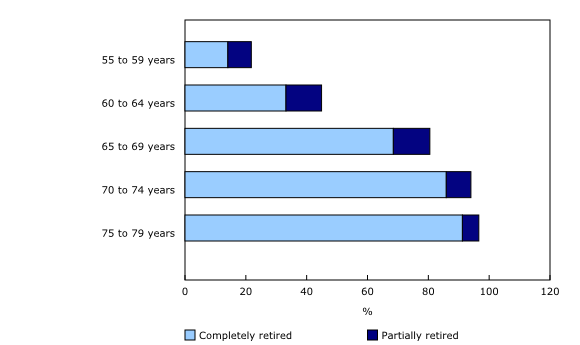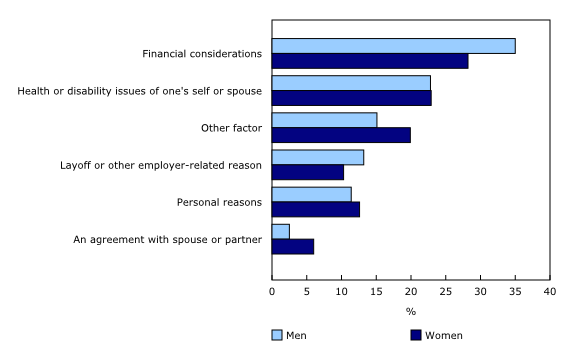Majority of people planning to retire would continue working longer if they could reduce their hours and stress
Released: 2023-08-01
As the Canadian population ages, the number of retirees increases, which puts downward pressure on labour supply and can lead to shortages of skilled and experienced workers. It may also create challenges for employers, including increased training and recruitment costs. At the same time, increased labour force participation among older workers can help alleviate the impacts of population aging on the labour market.
In June 2023, just over one-fifth (21.8%) of Canadians aged 55 to 59 years reported that they were either completely or partially retired. This proportion doubled to more than two in five (44.9%) for those aged 60 to 64 years, then nearly doubled again to four in five (80.5%) for those aged 65 to 69 years. After the age of 70 years, the proportion of people in retirement reached a plateau, with over 90% of Canadians in that age group reporting they were completely or partially retired.
Timing of retirement driven by financial and health considerations
Among those who reported being completely retired, over one-third (35.0%) of men and more than one-quarter (28.2%) of women cited financial reasons as the main factor in determining the timing of their retirement. People in this group reported that the most important factor was either that they were financially ready, they had qualified for a pension, or had deferred the start of their Old Age Security pension in exchange for a larger amount.
Health was another top consideration in determining the timing of retirement, which indicates that some people had stopped working earlier than they would have otherwise chosen. Close to one-quarter of men (22.8%) and women (22.9%) who were completely retired cited issues related to health or disability, either their own or their spouse's, as the main factor.
People retiring for health or disability reasons were more likely to have stopped working at a younger age. Among men in this group, the average age at retirement was 58.5 years, almost four years younger than those who reported financial considerations as the main factor (61.7 years).
Similar observations can be made for women: among those who cited health reasons as the main factor in determining the timing of their retirement, the average age at retirement was 56.9 years, compared with 60.1 years for those who reported financial considerations as the main factor.
More than half of people planning to retire would continue working part-time
As the population continues to age, employers may want to develop incentives to retain experienced workers, and some seniors may choose to work longer if they could reduce their hours and their stress.
Among people who had not completely retired but were planning to retire, more than half (55.1%) reported that they would continue working longer if they could work part-time, and about half (48.9%) reported that they would continue working if they could work fewer hours without affecting their pension.
Others said they would continue working if it were less stressful or physically demanding (43.0%) or if they had the opportunity to do more interesting work (37.6%). A further 34.2% cited pay or salary increases as motivation to continue working, and 29.3% would continue working if their health improved.
Note to readers
The data source for this release is the June Labour Force Survey (LFS), which had a reference period of June 11 to 17, 2023.
While the main objective of the LFS is to provide information on the characteristics of the labour force, the LFS collects additional information on quality of employment through monthly and quarterly supplementary questionnaires. In June, additional questions on retirement were asked to respondents aged 55 to 80 years.
Contact information
For more information, or to enquire about the concepts, methods or data quality of this release, contact us (toll-free 1-800-263-1136; 514-283-8300; infostats@statcan.gc.ca) or Media Relations (statcan.mediahotline-ligneinfomedias.statcan@statcan.gc.ca).
- Date modified:


